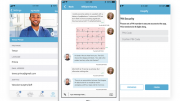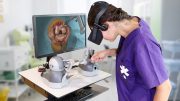Technology led changes – from the addition of robotics to the adoption of surgical ‘space suits’ – are having significant implications for operating room ergonomics. As Tom Downes, CEO, Quail Digital, explains, the way multi-skilled, multi-discipline teams need to interact with both technology and each other is creating a pressing requirement for more effective OR communication.
Communication Challenge
The rapid evolution of technology, not least robotics, is inspiring the next generation of ergonomic design to better understand the human / technology interaction. Within the OR, the development of 3D imagery, precise robotics, even protective garments with in-built air supply, are changing not only the type of procedures that can be considered but also the processes and the need for effective interaction between multi-skilled teams. From situational awareness to decision making, teamwork and coping with stress, in an increasingly technology dominated OR, team members’ cognitive and social skills are recognised to contribute to safe and efficient task performance.
However, as surgical teams are increasingly reporting, while the innovation is compelling, technology led procedures are raising challenges – not least with the quality and timing of essential team communication. With a growing reliance on data, imagery, graphics and cameras, individuals are rarely looking at each other or even directly at the patient. Indeed, many individuals are moving around within, but also in and out of, the OR. Not only are they blind to the progress of the procedure, but they can also struggle to share essential information with the rest of the team. Furthermore, as technology takes an increasingly dominant role, there is a risk that clinical teams feel they have only a supportive role and potentially lose engagement.
For many Trusts, additional challenges are created in medical environments that are still in transition between paper based and electronic records, a situation that is proven to create new problems that can lead to mistakes. From the ability to verify information to fostering teamwork, ensuring people share the right information at the right time and reinforcing situational awareness, effective communication is essential to the safe utilisation of technology innovation.
Effective Human Machine Interaction
To create and retain a calm, stress free environment, growing numbers of surgical teams are now exploring the value of high quality wireless headsets that enable every team member to be part of the procedure from beginning to end. Using one channel, the lightweight headsets provide simple, effective communication where every team member is part of the process and can quietly comment, provide essential insight from the imagery or data, or request information when required.
Linking up every team member via headsets, from the initial pre-op discussion to the end of the procedure, fosters an essential level of collaboration. It enables effective, unambiguous speech between multiple specialists during a highly complex procedure. It supports training by empowering junior doctors, for example, to ask questions without feeling they are interrupting the procedure. And it can be used to keep everyone engaged during the routine, increasingly high-throughput procedures, such as joint replacement.
Evolving Ergonomics
The quality of communication has a direct implication on risk, safety and patient well-being – but it also provides a vital platform for successful utilisation of technology. Overcoming communication barriers is the foundation for ORs to embrace the evolution in human / technology interaction – including the maximising the social and personal skills including situation awareness, decision making, teamwork and coping with stress. When the communication works, the rest of the new OR ergonomics can fall into place.





